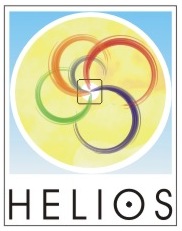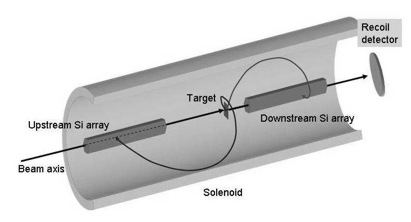 Helical Orbit Spectrometer
Helical Orbit Spectrometer
Studying Reactions with Short-Lived Beams
A new concept has been developed for simple reactions with radioactive beams. It is ideally adapted to the `inverse kinematics' regime necessary for nuclear structure studies in an exotic domain of great current interest. The concept is based on a superconducting solenoidal spectrometer with uniform axial field. The target and detector are both on the solenoid axis in the field with the reaction products bent back to the axis. The target-to-detector distance and the energy of the particles translate into the desired information of excitation energy and center-of-mass angle.
Such a device has a number of attractive features: greatly improved effective resolution, large solid angle, compact detectors and electronics, and easy particle identification. It is well suited to experiments that probe the structure of the exotic nuclei that are currently of high interest: single-nucleon transfer reactions, pair transfer, inelastic scattering, or even knockout reactions.
The device consists of a 0.9-m bore, and 2.0 m long 3 T superconducting solenoid (i.e., MRI magnet). It has been commissioned, tested and used at ATLAS with secondary short-lived beams. It also has the potential of being moved to other facilities with short-lived secondary beams if such a move is warranted. Construction and use of the device will also provide valuable experience in a technique that is very relevant to the scientific program of the future facility for rare isotope beams.
For more information on this project contact Ben Kay or Birger Back.
Recent Publications (Full List)
- Structure of 14C and 14B from the 14,15C(d,3He)13,14B reactions
S. Bedoor, A. H. Wuosmaa, M. Albers, M. Alcorta, Sergio Almaraz-Calderon, B. B. Back, P. F. Bertone, C. M. Deibel, C. R. Hoffman, J. C. Lighthall, S. T. Marley, D. G. Mcneel, R. C. Pardo, K. E. Rehm, J. P. Schiffer, and D. V. Shetty
Phys. Rev. C 93, 044323 (2016)
- Stretched states in 12,13B with the (d,α) reaction
A. H. Wuosmaa, J. P. Schiffer, S. Bedoor, M. Albers, M. Alcorta, S. Almaraz-Calderon, B. B. Back, P. F. Bertone, C. M. Deibel, C. R. Hoffman, J. C. Lighthall, S. T. Marley, R. C. Pardo, K. E. Rehm, and D. V. Shetty
Phys. Rev. C 90, 061301(R) (2014)
- Single-neutron excitations in 18N
C. R. Hoffman, M. Albers, M. Alcorta, S. Almaraz-Calderon, B. B. Back, S. I. Baker, S. Bedoor, P. F. Bertone, B. P. Kay, J. C. Lighthall, T. Palchan, R. C. Pardo, G. Perdikakis, K. E. Rehm, A. M. Rogers, D. Santiago-Gonzalez, Cenxi Yuan, and J. P. Schiffer
Phys. Rev. C 88, 044317 (2013)
- Structure of 14B and the evolution of N=9 single-neutron isotones
S. Bedoor, A. H. Wuosmaa, J. C. Lighthall, M. Alcorta, B. B. Back, P. F. Bertone, B. A. Brown, C. M. Deibel, C. R. Hoffman, S. T. Marley, R. C. Pardo, K. E. Rehm, A. M. Rogers, J. P. Schiffer, and D. V. Shetty
Phys. Rev. C 88, 011304(R) (2013)
- Neutron single-particle strength outside the N=50 core
D. K. Sharp, B. P. Kay, J. S. Thomas, S. J. Freeman, J. P. Schiffer, B. B. Back, S. Bedoor, T. Bloxham, J. A. Clark, C. M. Deibel, C. R. Hoffman, A. M. Howard, J. C. Lighthall, S. T. Marley, A. J. Mitchell, T. Otsuka, P. D. Parker, K. E. Rehm, D. V. Shetty, and A. H. Wuosmaa
Phys. Rev. C 87, 014312 (2013)
- Experimental study of the 19O(d,p)20O reaction in inverse kinematics
C. R. Hoffman, B. B. Back, B. P. Kay, J. P. Schiffer, M. Alcorta, S. I. Baker, S. Bedoor, P. F. Bertone, J. A. Clark, C. M. Deibel, B. DiGiovine, S. J. Freeman, J. P. Greene, J. C. Lighthall, S. T. Marley, R. C. Pardo, K. E. Rehm, A. Rojas, D. Santiago-Gonzalez, D. K. Sharp, D. V. Shetty, J. S. Thomas, I. Wiedenhöver, and A. H. Wuosmaa
Phys. Rev. C 85, 054318 (2012)
![[Argonne Logo]](/images/argonne_header_logo.jpg)
![[DOE Logo]](/images/header_doe.gif)